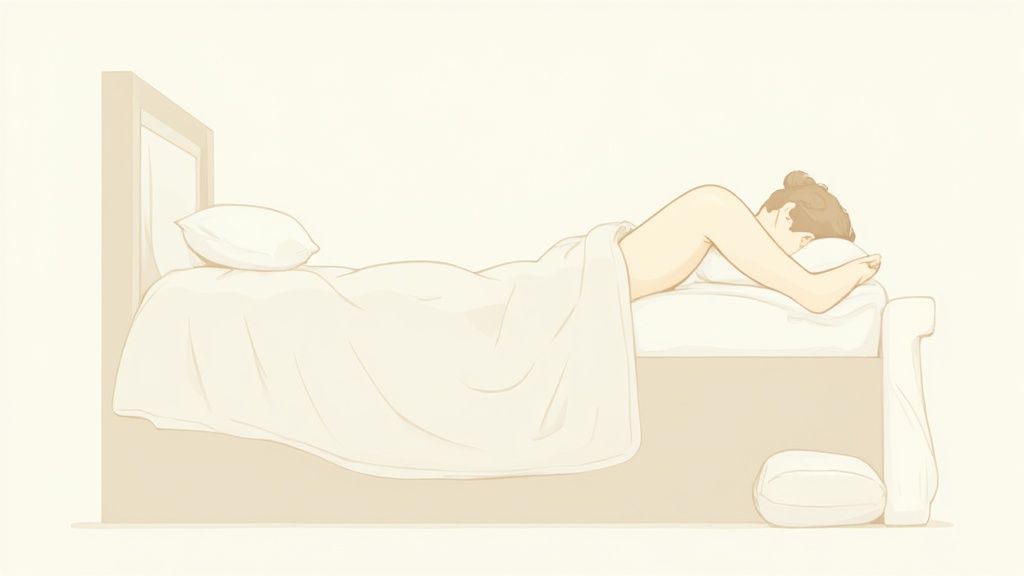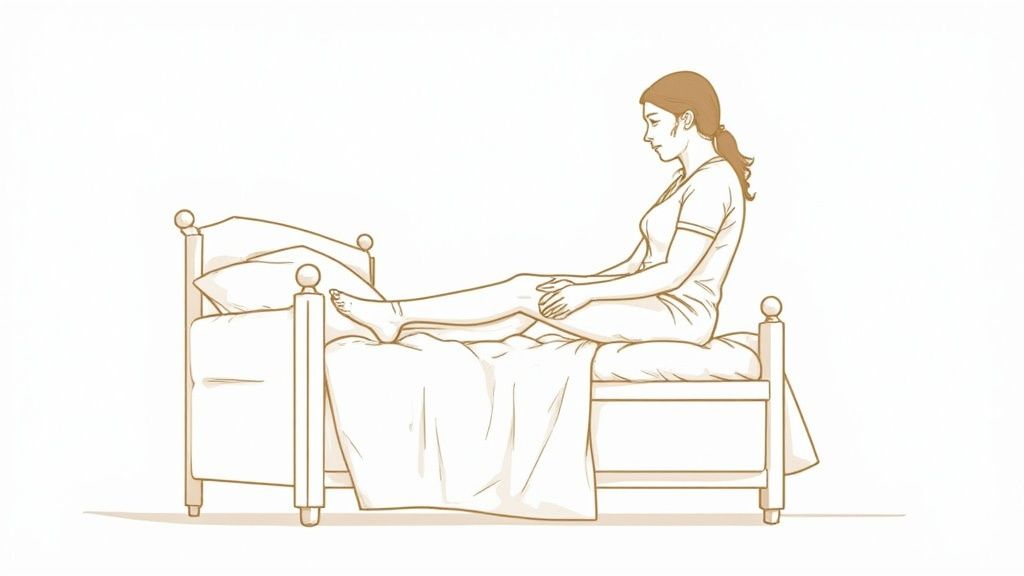If that throbbing heel pain from plantar fasciitis is ruining your sleep, you're not alone. The good news is that relief often comes down to a simple, consistent nighttime routine. It's really about combining a few key things: finding the right sleep position, doing some gentle stretches before bed, and sometimes using supportive gear to keep your foot in a good spot.
These strategies all work toward the same goal: preventing your plantar fascia from tightening up while you sleep. That tightening is the real culprit behind that awful, sharp pain you feel first thing in the morning.
Your Guide to a Pain-Free Night

There’s nothing more frustrating than finally getting into bed, ready for a good night's rest, only to be kept awake by a dull, persistent ache in your heel. For many, this pain seems to amplify in the quiet of the night, turning what should be a time of healing into a long, exhausting ordeal.
The root of this nighttime and morning misery is what your foot does when you're not on it. As you sleep, your foot naturally relaxes and points downwards. This position, called plantar flexion, allows the plantar fascia ligament to shorten and stay that way for hours. When you stand up in the morning, that contracted tissue is suddenly forced to stretch, causing tiny tears and that familiar stabbing sensation.
Getting a handle on this cycle is the first real step toward breaking it. If you want a deeper dive into the mechanics, you can read our guide on what is plantar fasciitis.
A Three-Pillar Approach to Nighttime Relief
To really tackle this pain, you need a plan that covers all the bases. Just doing a few calf stretches here and there probably won't cut it. A much better way to think about it is building a routine around three core pillars that support each other.
This isn't just a list of tips—it's a complete strategy for how to sleep better with plantar fasciitis.
To make it simple, I've broken down this approach into a quick reference table. Think of these as the three essential ingredients for a more comfortable night and a much less painful morning.
Three Pillars for Better Sleep with Plantar Fasciitis
| Strategy Pillar | Primary Goal | Key Action |
|---|---|---|
| Preparation | To relax the muscle and fascia | Gentle stretching and massage right before bed. |
| Positioning | To prevent foot-pointing | Sleeping on your back with pillows to keep feet neutral. |
| Support | To maintain a gentle stretch | Using a night splint or sock to hold the foot at 90 degrees. |
By combining these three elements—preparation, positioning, and support—you create an environment where your foot can actually rest and heal, not just tighten up and prepare for another painful morning.
This condition is far more common than you might think. It's estimated that 1 in 10 people will deal with plantar fasciitis at some point. In the U.S. alone, about 2 million people seek treatment for it every year.
Ultimately, learning how to manage your symptoms at night is a critical piece of your recovery puzzle. The goal is to shift from restless nights of discomfort to deep, restorative sleep that lets your body heal. When you do that, you'll start waking up refreshed and with far less pain greeting your first steps of the day.
Finding Your Best Sleep Position

Think about it—you spend roughly eight hours in bed every night. The way your body is positioned during that time can either make your plantar fasciitis feel a lot better or a whole lot worse. Most advice just tells you to sleep on your back, but let's be realistic; that's not how everyone is comfortable.
So, let's talk about real-world adjustments for every type of sleeper.
The big goal here, no matter how you sleep, is to stop your foot from pointing downward all night. That position, which we call plantar flexion, is the real enemy. It lets the fascia ligament shorten and tighten up, which is exactly why those first few steps out of bed feel like walking on glass. A few simple tweaks can change everything.
The Best Position for Back Sleepers
If you’re already a back sleeper, you're in a great spot to make some quick improvements. The main goal is to prevent your feet from naturally dropping forward into that pointed position. You want to keep them in a more neutral, slightly flexed state known as dorsiflexion.
A common mistake is trying to prop your feet way up high, which just feels weird and makes it hard to sleep. We're looking for subtle support, not a major change.
- Pillow Under Your Knees: This is a classic for a reason. Sliding a pillow under your knees takes the pressure off your lower back and helps your hamstrings relax. Less tension in your legs means less pull on your calves and, by extension, your plantar fascia.
- A Second Pillow at Your Feet: Try a smaller, softer pillow right at the end of the bed, just under your ankles. This creates a gentle lift that keeps your feet from pointing down and takes the pressure right off your heels.
These two pillows work together to create a supportive little nest for your legs, encouraging a better foot angle all night long.
Smart Adjustments for Side Sleepers
Most people sleep on their side, but it comes with its own set of problems for plantar fasciitis. When you're on your side, your top leg often slides forward and down, causing your foot to point toward the mattress—the exact position we’re trying to avoid.
Luckily, the fix is all about getting your hips aligned.
Pro Tip for Side Sleepers: Sticking a firm pillow between your knees is a total game-changer. It aligns your hips and spine, stopping that top leg from rotating forward. This tiny adjustment keeps your foot in a much healthier position without you even realizing it.
This is just good practice for your back and hips anyway, so you get a double win: less heel pain and a happier spine in the morning.
Honest Advice for Stomach Sleepers
I'll be straight with you: sleeping on your stomach is the absolute worst position for plantar fasciitis. There's just no way around it. It forces your feet into that pointed-toe, plantar flexion position for hours on end.
If you just can't imagine sleeping any other way, you'll need a creative workaround. The best strategy is to let gravity do the work for you.
Try this: scoot down in your bed so your feet hang completely off the edge. This allows your ankles to relax into a more natural 90-degree angle instead of being jammed into the mattress. It might feel a bit odd at first, but it’s a much better option than waking up to that familiar, searing pain.
Finding the Right Night Splint for You

A night splint can be an absolute game-changer for plantar fasciitis, but let's be honest—staring at all the options online can feel overwhelming. They all promise the same thing: to hold your foot in that perfect 90-degree angle to keep the plantar fascia from tightening up while you sleep. The reality is, they vary wildly in comfort, bulk, and how they actually feel on your foot.
Choosing the right one really boils down to your own pain level and sleep habits. The bulky, heavy-duty splint that works wonders for your friend who sleeps like a log might be kicked off by a restless sleeper like you within an hour. Let’s walk through the main types so you can find one you’ll actually use.
It’s no secret that managing this condition gets expensive. The national cost for just evaluating and treating plantar fasciitis hits around $284 million every year. A big chunk of that goes to supportive gear like splints and orthotics. For a deeper dive into these costs and treatment trends, the plantar fasciitis statistics on KuruFootwear.com offer some eye-opening insights.
Dorsal Splints vs. Boot-Style Splints
When you get right down to it, most night splints fit into two camps: dorsal splints (worn on top of the foot) and boot-style splints (a more rigid cradle for your foot and calf). Each has its pros and cons, and the best one for you depends entirely on your needs.
Dorsal Splints (Top of Foot)
- Best For: Restless sleepers and anyone who gets claustrophobic.
- How They Work: These sit on the front of your ankle and shin, using straps to pull your toes up toward your shin. This design leaves your heel and arch completely free, which feels much cooler and less constricting to most people.
- The Trade-Off: Since they're less bulky, the stretch they provide can sometimes feel less intense. You might have to play around with the straps to get the tension just right and prevent your foot from slipping out.
Boot-Style Splints (Back of Foot)
- Best For: People with severe morning pain or those who tend to stay put all night.
- How They Work: This is the classic, more traditional design—a hard plastic shell that runs up the back of your calf and under your foot, locking it firmly in place.
- The Trade-Off: There's no sugarcoating it: they are bulky. They can feel restrictive, make your foot hot, and their sheer size can make it tough to get comfortable, especially if you're a side sleeper.
The most important thing to remember is this: the "best" splint is the one you will actually wear all night long. A super-effective boot that you rip off at 2 AM does you no good. A softer dorsal splint that stays on until your alarm goes off is a much better choice.
Getting the Fit and Feel Right
Once you’ve picked a style, you have to get used to wearing it. The first few nights will probably feel a little weird, so don't give up if it isn't perfect right away. Your goal is a gentle, consistent stretch—not a painful, aggressive pull.
The splint should be snug, but it should never cause numbness, tingling, or more pain. If you wake up with numb toes, the straps are definitely too tight. Loosen them up a bit the next night. It’s a bit of trial and error.
Finally, remember that a night splint is just one piece of the puzzle. What you do during the day matters just as much. Combining your nighttime routine with excellent daytime support is key, which is why finding the best insoles for plantar fasciitis can dramatically speed up your recovery.
A Simple 10-Minute Routine Before You Sleep

I get it—the last thing you want at the end of a long day is another chore. But trust me, spending just 10 minutes on your feet before bed can completely change your night. Think of it as a wind-down ritual, a moment to signal to your body that it's time to heal.
This quick routine is all about releasing the tension that's built up in your feet and calves all day. When those tissues are tight, they shorten overnight, which is exactly why those first few steps in the morning are so excruciating. A little pre-sleep attention can stop that painful cycle before it begins.
The Stretches That Really Matter
Consistency is your best friend here. Doing these stretches every single night is what makes the real difference.
-
Classic Wall Calf Stretch: Find a clear wall and stand facing it, placing your hands on it for balance. Step one foot back, making sure to keep that leg straight and your heel firmly on the floor. Now, gently lean your hips forward until you feel a good, solid stretch in your calf. Hold it for about 30 seconds—no bouncing! Repeat this three times for each leg. You're looking for a deep pull, not a sharp pain.
-
Towel Stretch (from the floor): Sit on the floor with your legs straight out. Grab a small towel, a yoga strap, or even a t-shirt and loop it around the ball of one foot. Keeping your knee straight, gently pull the ends of the towel towards your body. You should feel this stretch along the bottom of your foot and up into your calf. Hold for 30 seconds, then switch. Aim for three repetitions on each side.
These two moves are my go-to recommendations because they directly target the tight fascia and the connected calf muscles, giving you immediate relief.
Pro Tip: Combine your stretching with a bit of cold therapy. After you're done, grab a frozen water bottle from the freezer and spend five minutes rolling your foot over it. It’s a fantastic two-for-one: you get a gentle massage while the cold tackles the day's inflammation.
A Little Self-Massage Goes a Long Way
After stretching, a little hands-on work can make a huge impact. It doesn't have to be complicated.
Just spend a couple of minutes using your thumbs to press firmly along the arch of your foot, working from the heel bone up toward your toes. This simple massage helps get blood flowing and can break up some of those stubborn, tight spots.
Finish up with some easy ankle rotations. Gently circle your foot clockwise 10 times, then counter-clockwise 10 times. This keeps the joint from getting stiff and locked up overnight.
This entire sequence—stretch, ice, massage—takes maybe 10 to 15 minutes tops. Make it a non-negotiable part of your bedtime routine, and you'll set yourself up for a much more comfortable night and a far less painful morning.
Daytime Habits for Better Nights
If you're tired of plantar fasciitis pain waking you up at night, the solution often starts much earlier in the day. What you do from the moment you get out of bed directly impacts how your feet will feel when you finally lie down.
Think of it this way: your plantar fascia is already inflamed and overworked. Every step you take during the day can either help it heal or aggravate it further. It’s these small, consistent daily habits that really set the stage for a pain-free night.
Your Shoes Are Your First Line of Defense
Honestly, the single most important decision you'll make all day is what you put on your feet. Walking around in flimsy, unsupportive shoes—or even worse, going barefoot on hard floors like tile or wood—is practically an invitation for a painful night. That constant, unsupported pressure puts a massive strain on your already-injured ligament.
The goal here is simple: give your feet consistent support, all day long.
- Ditch the Barefoot Habit: I can't stress this enough. Keep a pair of supportive slippers or sandals right by your bed. The very first steps you take in the morning should be into something cushioned, never onto a hard, unforgiving floor.
- Look for Real Arch Support: Your everyday shoes need to have a solid, firm arch and a well-cushioned heel. This isn't just about comfort; it's about properly distributing your weight and taking the pressure off that sore spot.
- Upgrade with Quality Insoles: A good pair of insoles can transform an average shoe into a fantastic one for your feet. If you want to dive deeper into this, learning what to do for plantar fasciitis is a great next step in building a supportive environment for your feet.
This isn't just about feeling good in the moment. It's about actively preventing the tiny tears and inflammation that build up during the day and cause that throbbing pain at night.
Lighten the Load on Your Feet
Beyond your shoes, a few other key lifestyle choices can dramatically change how much stress your feet endure. The two biggest game-changers I see with my clients are managing weight and staying hydrated.
Every extra pound you carry adds significant force to your plantar fascia with every step. I've seen clients experience incredible relief after losing just a small amount of weight because it drastically reduces the daily load their feet have to bear. Less strain during the day means far less inflammation and pain at night.
It's no surprise that plantar heel pain is so common—it accounts for 11–15% of all foot complaints in some practices. This highlights just how crucial it is to manage daily stress factors. You can discover more about these findings and what they mean for effective treatment.
Hydration is another simple but powerful tool. When you're dehydrated, your muscles are more prone to cramping and your body has a harder time flushing out inflammation. Just sipping water consistently can make a real difference.
And while you're at it, think about what you're eating. Adding anti-inflammatory foods like berries, fatty fish, and leafy greens can help your body fight inflammation from the inside. These may seem like small changes, but they all add up, creating a foundation for a much quieter, more comfortable night.
Your Top Questions, Answered
Alright, even after laying out a solid plan, I know you probably have some specific questions nagging at you. Getting those cleared up is a big part of feeling in control of your plantar fasciitis, especially at night. Let's dig into some of the most common ones I hear.
This isn't about getting bogged down in medical-speak. It's about getting you simple, practical answers you can put to use tonight.
Should I Wear Socks to Bed?
This is a great question, and my answer is usually, "It depends on the sock." Your standard cotton socks aren't going to make a difference with the pain, but the right kind of sock can be a real game-changer.
We're talking about compression socks or those socks made specifically for plantar fasciitis. They give your arch and heel a gentle, constant hug. This pressure helps boost circulation and keep overnight swelling in check. It also keeps your fascia from getting too tight while you sleep.
Now, if you're already using a night splint, trying to cram a thick compression sock in there is probably going to be way too tight and uncomfortable. In that case, just a thin, breathable sock is perfectly fine for comfort.
The takeaway here? While socks aren't a magic cure, the right pair can be a fantastic part of your nighttime routine. They're a great option for milder pain or for anyone who just can't stand sleeping in a bulky brace.
Why Does My Heel Hurt More at Night or in the Morning?
It’s one of the most frustrating parts of this condition, isn't it? You lie down to rest, and the pain seems to ramp up. The classic "first-step pain" in the morning is infamous for a reason: your plantar fascia ligament shortens and tightens up all night long. When you take that first step, you're suddenly stretching that cold, stiff tissue, which causes that sharp, stabbing feeling.
But what about the throbbing at night? That's a different beast. All day long, every step you take can create a little more inflammation in the ligament. When you finally stop moving and the distractions of the day melt away, that built-up inflammation suddenly has your full attention.
Should I Use Ice or Heat on My Foot Before Bed?
When it comes to killing that pre-sleep pain, ice is almost always the better choice. Your main goal right before bed is to calm down the inflammation from your day's activities.
Rolling your foot over a frozen water bottle for about 15 minutes is a perfect way to do this. It helps numb the area and reduce swelling, which can make it a whole lot easier to drift off to sleep.
Heat, on the other hand, is generally better for loosening up tight muscles. A warm foot soak might feel nice and relaxing, but it can sometimes make inflammation worse if you use it at the wrong time. For that immediate nighttime pain relief, stick with cold therapy.
How Long Until a Night Splint Starts Working?
With night splints, patience and consistency are everything. I've had clients say they felt a difference in their morning pain after just a couple of nights, but that's not the norm. It's definitely not an instant fix for most people.
You should plan on several weeks of consistent, nightly use before you see a really significant, lasting change. It's so important to remember that the splint is just one tool in your toolbox. It does its best work when you're also doing your pre-bed stretches and wearing supportive shoes during the day. Don't give up if you don't wake up pain-free on day two—stick with it.
Ready to give your feet the daytime support they need for more peaceful nights? Samurai Insoles were designed by a podiatrist to fight overpronation and take the strain off your plantar fascia with every single step. Try them for 60 days, risk-free, and feel the difference for yourself.



